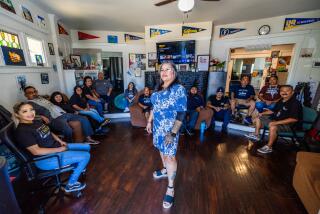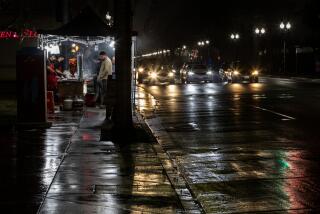Small-Town Success
- Share via
Monrovia is the sort of small city that at first glance could be Any Suburb, USA. A grid of bungalow-lined lanes sandwiched between the San Gabriel Mountains and the Foothill Freeway, it even has downtown streets studded with faux cobblestones.
But the town of about 39,000, stands out as a national example of a “zero tolerance” approach to crime--in which police and city officials crack down on petty infractions--and for its emphasis on keeping children on the straight and narrow. It is the type of combined effort that experts say is contributing to the drop in crime nationwide.
Monrovia’s anti-truancy ordinance allows police to stop suspected truants and issue citations of $135 to those who turn out to be ditching school. The law was the model for a similar Los Angeles law and dozens of others nationwide. In addition, school uniforms are mandatory for elementary and middle school students in local public schools. Police patrol school bus routes. High school students seeking to escort out-of-towners to the prom must have their dates interviewed and approved by an assistant principal.
A handful of residents complain that the city is picking on its youngsters, noting that violent crimes are rising or holding steady despite the concentration on juvenile crime. But police, civic leaders and many residents argue that preventing petty crimes early--using measures some might see as draconian--can keep children from becoming violent offenders.
Some experts question whether Monrovia’s actions are making a permanent dent in crime. Although Monrovia is too small to be included in the just-released round of FBI crime statistics, it takes pride in a 15% drop in its serious crimes recorded by local police last year.
But it is hard to trace the roots of that drop. After all, reported serious crime throughout Los Angeles County had already decreased 15.6% between 1992 and 1994. Monrovia’s leaders say the greatest impact of their policies will be felt in the future.
“We really believe that if we prevent things from happening today, especially with our children, that they won’t become the criminals of tomorrow,” Police Chief Joseph Santoro said.
*
Monrovia’s high-profile laws stem from crime-fighting techniques that integrate people from all areas of the community. Most of the city’s anti-crime laws spring from a planning group that includes police, school officials, the Chamber of Commerce and nearly a dozen city departments.
“Monrovia is uniquely collaborative,” said Louise Taylor, superintendent of the Monrovia Unified School District.
The collaboration began in 1990, when the Police Department decided to combat a steady rise in property crimes with a comprehensive community-policing program, including targeting slumlords and requiring graffiti to be painted over in 24 hours. Last year, that program won a national award from a group of public employees.
The next step was the formation of a committee of local leaders to brainstorm anti-crime measures. That body generated two policies that were heralded by President Clinton during a 1996 campaign stop in Monrovia: The truancy law and the school uniform policy.
City leaders say those laws are in keeping with the town’s child-friendly ambience. The city’s big celebration is a year-round “Family Fun” festival downtown each Friday night, and the community center and library offer regular children’s events. The police chief and the superintendent keep each other’s home phone numbers handy to alert one another to any problems at the schools or on the streets. Police regularly patrol routes taken by school buses, and two officers from the 64-officer department are assigned to mentor at the schools full-time.
Police are proud of their programs, especially the truancy law, the basis for a proposed statewide daytime curfew being considered in the Assembly. They say that during school hours in the two years since the law was passed, burglary has dropped 54%, theft has dropped 48% and grand theft auto is down by 55%.
But a few residents say the efforts are misguided.
“I definitely sense a zero tolerance in Monrovia,” said Rosemary Harrahill, the mother of two home-schooled Monrovia teenagers whom police have stopped erroneously nearly two dozen times in their efforts to track down truants. “But it [should] depend on what they’re going after. Of course we want zero tolerance to gang violence, and rape and murder and pillage and all these other things,” added Harrahill, one of several residents who have joined to sue the city to have the law declared unconstitutional and voided.
Mike Males, a doctoral student at UC Irvine and author of the book “The Scapegoat Generation,” pointed out that neighboring cities like Arcadia have lower adult arrest rates for drug offenses and assault than Monrovia.
“Arcadia had more juvenile burglaries but fewer domestic assaults and fewer felony drug offenses [committed by] adults,” Males said. “If the Monrovia police are going to claim credit for reducing juvenile crime, do they want to take the blame for having greater felony drug arrests?”
“I’m just urging some skepticism about the city of the hour,” Males added.
In the streets of Monrovia, though, the zero tolerance approach is a hit.
“You have to try to keep kids busy so they stay out of trouble,” Elena Timko, 33, said as her 5-year-old daughter frolicked in a downtown park. “The parents should be involved though.”
That level of involvement can be difficult, even in a suburb like Monrovia, whose candy shops and historic downtown strives to capture Norman Rockwell’s America.
“When I was in high school some years ago, when you were not in school your neighbor would tell your parents,” said City Councilwoman Lara Blakely. “It was a different type of policing. Now a lot of neighbors [are] working, and they’re not there to make sure that so-and-so’s kids are going to school.”
“Our society and how it functions has changed. The Ozzie-and-Harriet model is not the majority, it’s the minority,” she said. “And the community has to somehow maintain support systems. In the absence of the traditional system of your neighbors, its natural for the parents to look to the schools to help them out.”
*
Police Chief Santoro acknowledges that much work remains to be done. Homicides doubled over the last year, from four to eight, and rapes and assaults have fluctuated. Santoro said these crimes are usually committed by adults, and are more difficult to prevent.
But the department and the rest of the city officials remain steadfast in believing they are on the right track.
“I’ve been in law enforcement a long time,” said Police Officer Bill Couch, who has worked the Monrovia schools for the last seven years, “and I’ve got to tell you, 20 years ago we were able to take kids to juvenile hall who were incorrigible or truant and keep them there for the weekend and it would scare them stiff.”
Those youths straightened up, Couch recalls. But truancy was decriminalized, and crime rose.
“Now,” Couch said, “we are going back to the way things were because we find it works.”
(BEGIN TEXT OF INFOBOX / INFOGRAPHIC)
Monrovia Profile
Officials in this San Gabriel Valley suburb credit a sharp drop in petty crimes to a policy of zero tolerance for offenses by young people.
*
Population: 39,100
Crime Statistics:
*--*
‘94’ ‘95 ’96 Murder 0 4 8 Rape 11 6 10 Robbery 100 100 75 Assault 130 114 75 Burglary 332 347 262 Larceny-Theft 901 848 743 Vehicle Theft 316 249 229
*--*
More to Read
Sign up for Essential California
The most important California stories and recommendations in your inbox every morning.
You may occasionally receive promotional content from the Los Angeles Times.










